Note: This website was automatically translated, so some terms or nuances may not be completely accurate.
LINE, Treasure Data, and Dentsu Inc. Discuss The Present and Future of Data Partnerships in the Cookie-Free Era
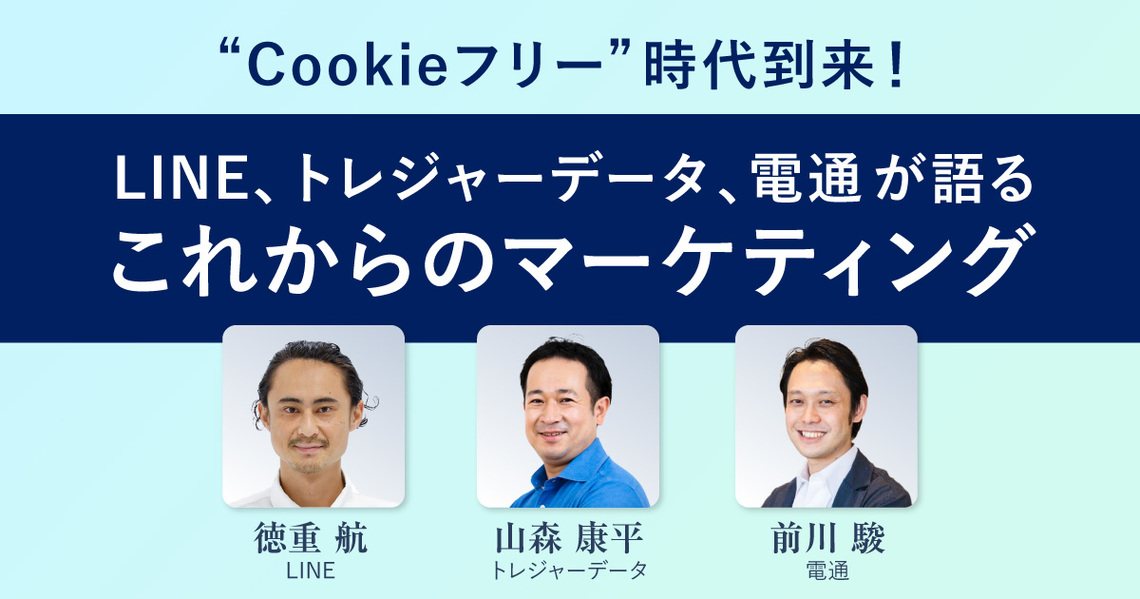
Amid growing momentum for data utilization and privacy protection, the digital marketing world is facing a major turning point, starting with cookie usage restrictions.
How should corporate marketing professionals navigate this pivotal moment?
This series features Treasure Data, which provides CDPs (Customer Data Platforms) to companies, and the Dentsu Group, with deep expertise in data-driven marketing, sharing the latest insights centered around the keyword "data."
This installment features a roundtable discussion with Wataru Tokushige of LINE, Kohei Yamamori of Treasure Data, and Shun Maekawa of Dentsu Inc., focusing on the themes of "First-Party Data Utilization as a Solution" and "Collaboration with Digital Platformers' Data."
<Table of Contents>
▼Not "Cookie-less," but "Cookie-Free." An Era Where Data Enriches Lives
▼CDPs and Data Clean Rooms Solve Clients' DX Challenges
▼LINE, with 89 million monthly active users, holds the key to data marketing
Not "Cookie-less," but "Cookie-Free." The Era Where Data Enriches Our Lives
──First, please introduce yourself.
Maekawa: I work in Dentsu Inc.'s Data & Technology Center, where I develop and operate data analytics solutions that support client marketing through data collaboration with platform providers.
We constantly explore questions like: "What form of data truly benefits people's daily lives?" and "How can data be used to move people emotionally?" Our work extends beyond advertising, implementing data collaboration in sales promotions and CRM (Customer Relationship Management) activities to drive DX in clients' business processes.
Tokushige: At LINE's Data Solutions Office, I handle business planning and development for utilizing LINE's data in advertising, including ad delivery and reporting functions in collaboration with external companies. I'm also involved in building a common data platform for the entire Z Holdings group, not just LINE.
Yamamori: At Treasure Data, I serve as the Executive Officer in charge of "Partnerships" and "Business Development." I build partnerships with companies like LINE that possess platforms, various data utilization tools, and solutions.
I also communicate to Treasure Data's client companies what is currently happening regarding themes attracting significant attention in society, such as the recent "data and privacy" issues, and what kind of response companies should take.
──First, I'd like to ask Mr. Maekawa. Digital marketing is said to be at a major turning point right now. What specific changes are occurring?
Maekawa: Amid growing momentum for privacy protection, legal frameworks governing personal data handling, such as GDPR (EU General Data Protection Regulation) and CCPA (California Consumer Privacy Act), have begun enforcement in various countries and regions. In Japan, the revised Personal Information Protection Act is scheduled to take effect in April 2022.
Technologically, a major change is the restriction on the use of "third-party cookies" and "app advertising identifiers." Consequently, this impacts methods like "retargeting," which relied on cookies, as well as advertising effectiveness measurement techniques such as "view-through conversion."
──How should corporate marketing professionals adapt during this transition period?
Maekawa: First and foremost, we must recognize that data is not owned by the company; it is entrusted to us by each individual with their permission. I believe that if the awareness that "data is entrusted to us by individuals" is deeply rooted, resistance to using terms like "harvesting," "acquisition," and "tracking" will naturally arise. This, I think, is the first step in exploring a "cookie-free" approach that allows us to handle personal data appropriately while still delivering benefits to users.
So, what actions should we take? Strategies will vary depending on the challenges of each product or service, so there's no one-size-fits-all solution. However, if I had to point to a common theme, it's the frequent feedback we hear from clients: "With the trend toward 'cookieless' environments and cookies becoming unusable, there's so much conflicting information out there that it's difficult to formulate a mid-to-long-term strategy across the entire organization."
Therefore, I believe it's crucial to first objectively survey the alternatives to cookies and the medium-to-long-term movements on the supply side (advertising delivery platforms) in response to this "cookieless" situation.
While there are various ways to summarize solutions for addressing cookie-less environments, one approach to gaining this overview is to focus on the nature of "IDs." This reveals three main approaches:
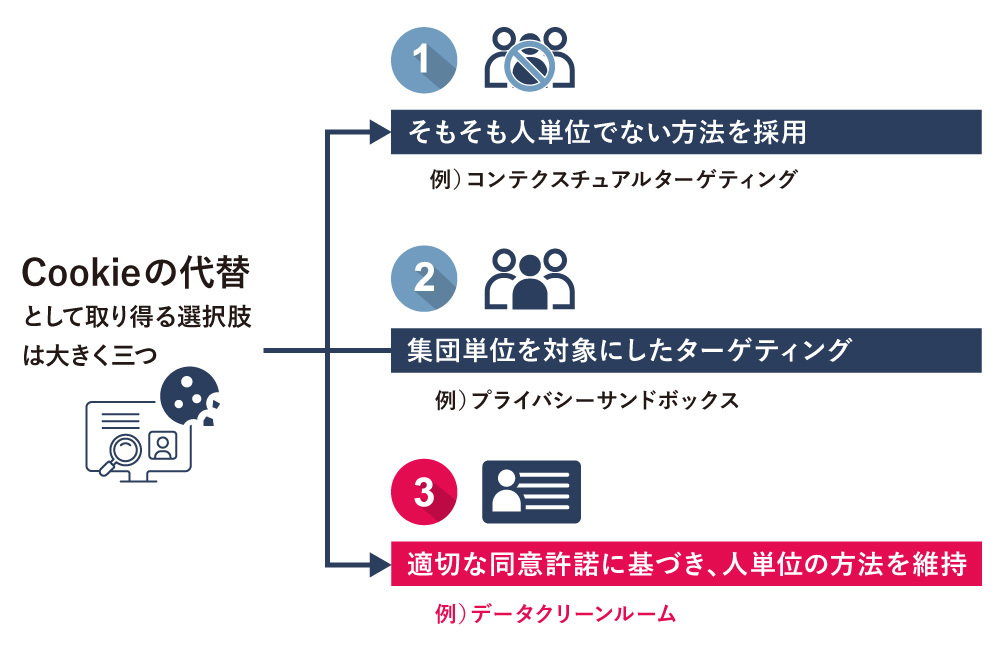
Maekawa: The first approach is "non-person-based targeting methods." A prominent example is "contextual targeting." While this solution existed previously, it is gaining renewed attention in the cookie-less context.
[Related Article]
"Contextual Targeting" – Astonishingly Effective! What is Next-Generation Programmatic Advertising?
https://dentsu-ho.com/articles/7879
The second approach is "building new targeting methods based on group units." For example, Google's "FLoC" (Federated Learning of Cohorts) treats groups of users with similar browsing habits as a single "cohort." It issues an ID for the cohort as a unit and uses this for targeting.
The third approach is "maintaining individual-level targeting based on appropriate consent." Many digital platform operators possess large-scale login IDs for which they have obtained "permission for marketing use," provided users benefits such as content, services, and points. They use these login IDs for analysis, targeting, and measurement. In light of the trend toward personal information protection, digital platform operators are advancing research and development on "how to protect privacy."
Solutions developed by various supply-side companies to address the cookie-less environment can be categorized into nine distinct areas when organized by three approaches (①–③) and three business processes: "ROI Analysis/Insight Analysis," "Ad Targeting," and "Ad Effectiveness Measurement & Optimization" (a)–(c).
While not exhaustive, aligning our solutions with these areas results in the following:
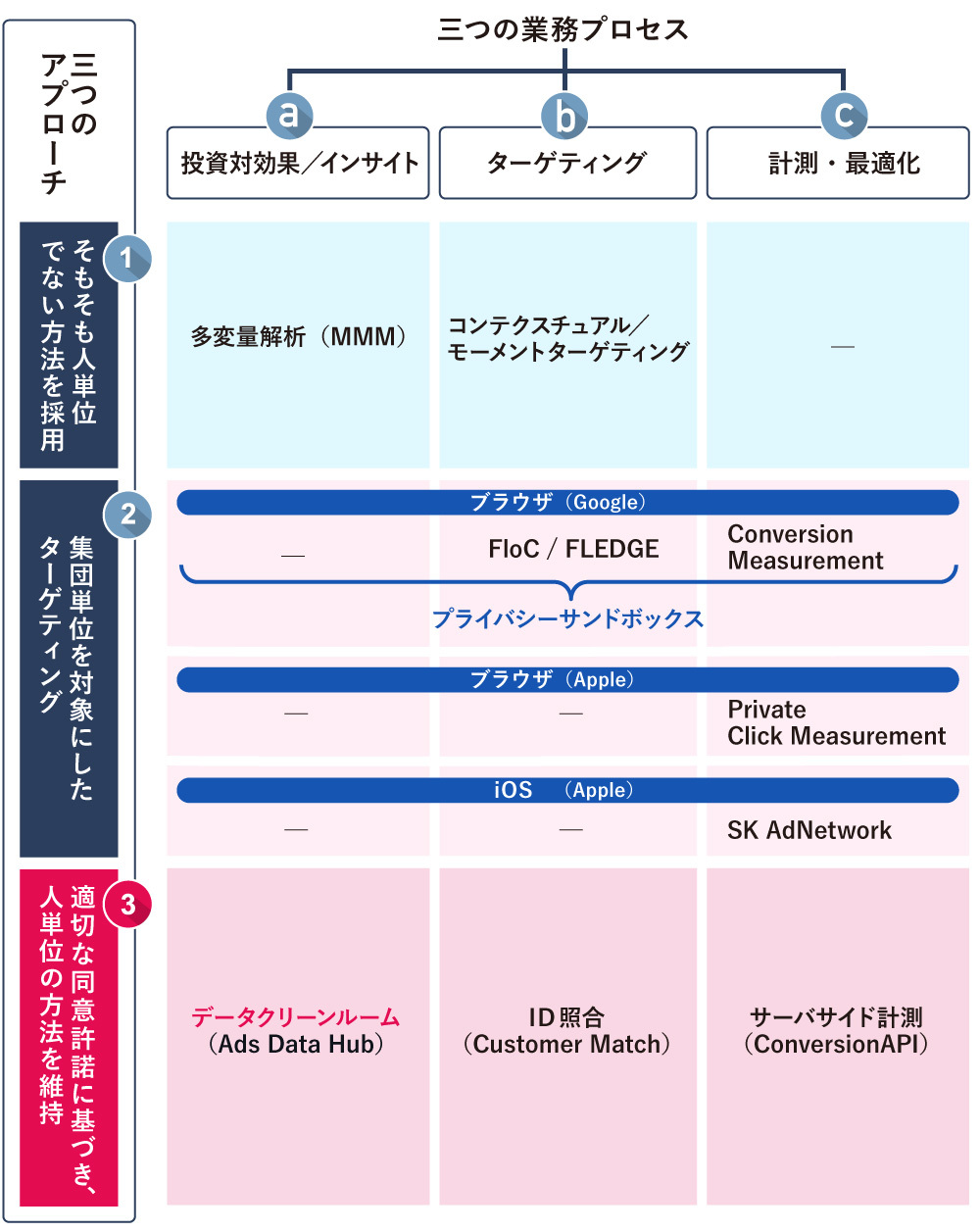
──There are various solutions. Is there one you're particularly focused on?
Maekawa: The solution you should adopt depends on your objectives. For today's theme, it's option ③. From the perspective of enhancing marketing value, we're putting significant effort into (a) data clean rooms.
[Related Article]
Data Clean Rooms Will Transform Marketing in the "Cookie-Free Era"
https://dentsu-ho.com/articles/7936
This is because the Dentsu Group has been promoting People Driven Marketing. However, to continue being chosen by clients as a partner, we must evolve this People Driven Marketing—which has primarily relied on cookies as its means—into a form more suited to the cookie-free era.
To maintain individual-level data based on appropriate consent, there is the "CDP (Customer Data Platform)"—a foundation enabling clients themselves to obtain consent from existing customers and utilize "first-party data" (data directly managed and owned by the company). This is precisely the domain where Treasure Data provides its services. It is a particularly powerful solution for CRM.
On the other hand, data clean rooms also encompass advertising initiatives as touchpoints with "new customers," while enabling CRM initiatives for "existing customers" through new touchpoints not previously available to the company.
From a CRM perspective focused on increasing customer lifetime value (LTV), the ability to operate both CDPs and data clean rooms as "two wheels" in a one-stop solution will become increasingly important.
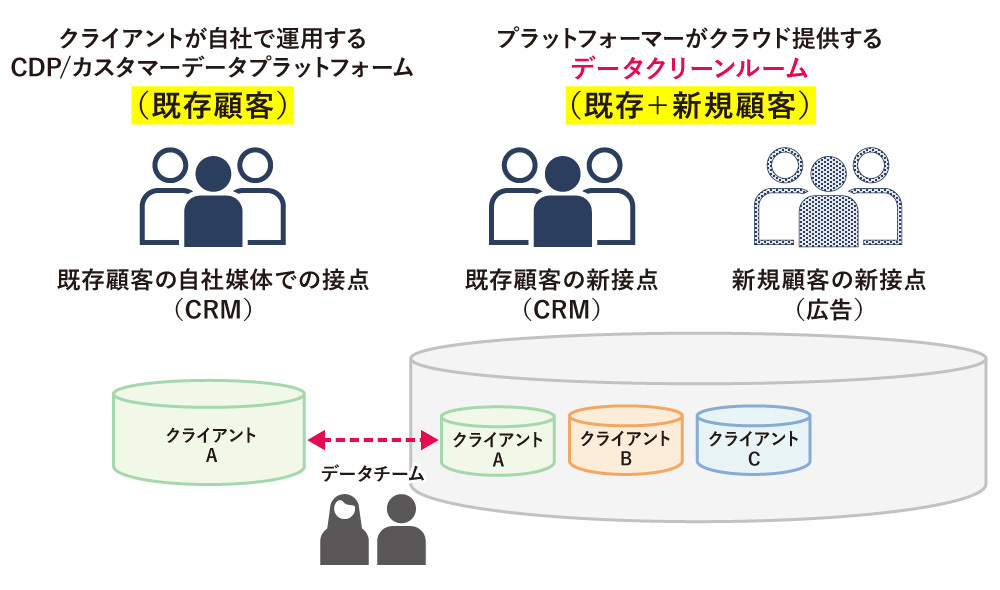
──Could you elaborate a bit more on the background and reasons for focusing on these solutions?
Maekawa: We believe that continuously driving both the CDP and data clean room wheels is the most effective way to "create a future where data better serves people's lives." We are aiming for a world where data is utilized more than ever before to enhance people's purchasing and experiential value.
At Dentsu Group, we view the phasing out of cookies as a positive change—one where data will make people's purchasing and media experiences more enjoyable and exciting.
Therefore, we refer to this trend as "cookie-free" rather than using the negative term "less," viewing it as the dawn of a new transformation.
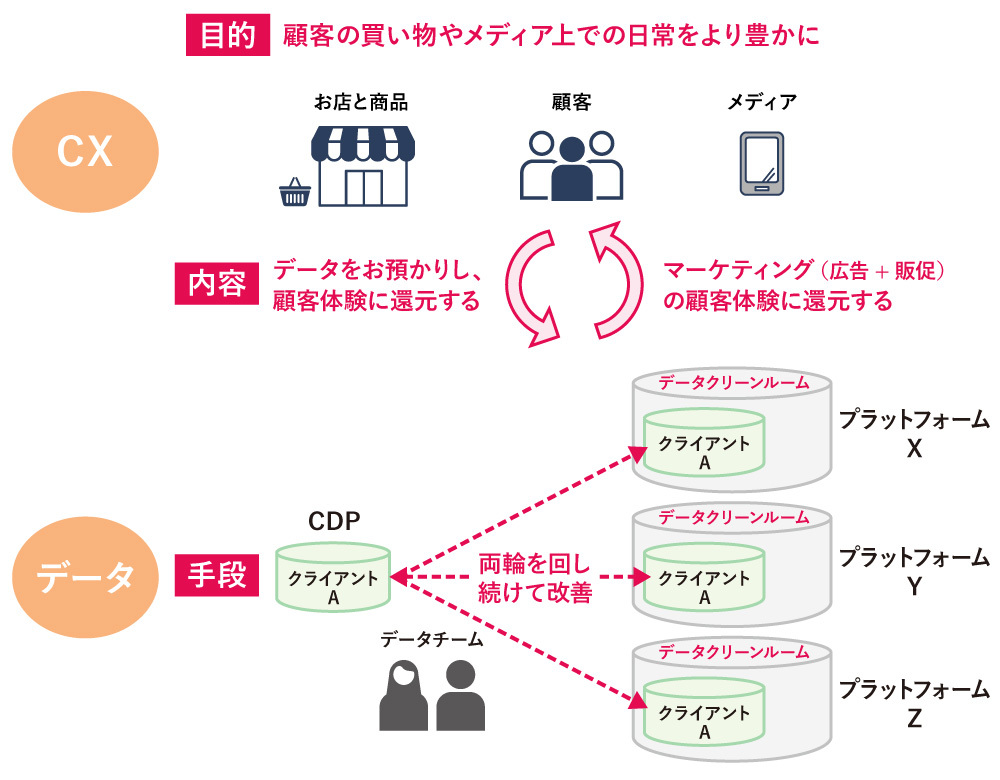
Maekawa: CDPs and data clean rooms fundamentally rely on customers entrusting us with their data. Therefore, they cannot be sustained unless they properly return the "value of data analysis" to customers' everyday experiences.
By continuously driving both wheels, we identify and resolve customer dissatisfaction (such as distrust, unnecessary data, unsuitability, or lack of urgency), ultimately enriching customers' shopping and daily media experiences. I believe this approach defines marketing in the cookie-free era.
CDPs and data clean rooms solve clients' DX challenges
──What are some current use cases for data clean rooms?
Maekawa: Regarding unique value offered by data clean rooms, we have a use case in promotional activities for a food manufacturer.
A marketer responsible for a food brand wanted to digitize their promotional activities, considering the costs of "attaching entry stickers to products" and "product delivery." However, they faced the challenge of hesitating to fully commit because the cost-effectiveness of digital promotions wasn't clear.
Therefore, as a trial, we implemented digital promotions and used the Data Clean Room to verify the "positioning" and "value" of digital promotions as a marketing strategy.
The results showed that digital promotions, requiring relatively less hassle for customers to obtain incentives, were perceived as valuable not only by those seeking points but by a broad range of customers. Specifically, analysis within the data clean room revealed the following three points:
- Approximately 65% of campaign participants were "new customers."
- Participation was high among customers in their 20s and 30s, a demographic not typically targeted in promotions.
- New customers continued purchasing products for up to two months after participating in the campaign.
While such verification may seem obvious at first glance, it represents an analysis case that was difficult to achieve in the real data world—especially in the cookie-based environment where estimation is involved and long-term effects are hard to observe.
──Next, we'll hear from Mr. Yamamori of Treasure Data. How do these changes connect to Treasure Data's initiatives?
Yamamori: Yes, to complement Mr. Maekawa's remarks, let me introduce Treasure Data's solution. Advertisers who are Treasure Data clients are now facing unprecedented demands for "privacy considerations." Beyond compliance with laws and regulations, obtaining individual consent before conducting marketing or CRM activities is becoming more critical than ever.
Moving forward, expanding customer data using third-party cookies via public DMPs is also expected to become more difficult. The accuracy of digital marketing initiatives, such as retargeting, may also decline. How should we respond to this situation?
First and foremost, companies must prioritize reliably acquiring their own first-party data. Then, after obtaining user consent for its use, important applications will include methods like integrating this data with digital platform providers' data within data clean rooms.
The next key point after "acquisition" is the "management" of first-party data. Some companies store data in separate systems like SFA (Sales Force Automation), CMS (Content Management System), and CRM (Customer Relationship Management) tools, making it difficult to connect them.
In other words, because data is managed separately by department, valuable data isn't connected end-to-end. This hinders its effective use in marketing initiatives and makes measuring results difficult. This is the so-called "data siloing." As a result, a comprehensive understanding of users doesn't progress, leading to missed opportunities for cross-selling and upselling proposals, or even customer churn.
Our solution to this problem is Treasure Data CDP, a platform that enables integrated management of various internal data.
──How is Treasure Data CDP being used to solve this challenge?
Yamamori: For example, the corporate sales team at SoftBank Group is advancing data aggregation in Treasure Data CDP to manage the sales activities of 3,000 sales representatives. Additionally, for the large-scale event "SoftBank World" hosted by SoftBank Group, post-event follow-up for approximately 120,000 participants is also centrally managed and operated using Treasure Data CDP.
Next, USEN ICT Solutions faced the challenge of "data being scattered and not sufficiently utilized for sales activities." However, by integrating data with Treasure Data CDP, they succeeded in improving gross profit and significantly shortening the lead time from lead generation to sales closing.
For advertising companies, alongside leveraging first-party data, integration with data from digital platform providers is crucial.
──In August 2021, LINE and Treasure Data announced enhanced collaboration.
Yamamori: By connecting their own first-party data with the data held by digital platform providers, companies can gain a deeper understanding of their users. In that sense, strengthening the partnership with LINE, which had 89 million monthly active users (as of September 2021), holds significant importance.
One example of LINE and Treasure Data CDP working together is a campaign by a beverage manufacturer. Previously, they ran campaigns where participants had to cut off stickers from cans, paste them onto postcards, and mail them in. Data collection was manual and not properly accumulated.
Therefore, they switched all campaign entries to be made via LINE, essentially shifting the data input process to the users themselves. By analyzing this data, they achieved communication that went beyond simply having users enter a campaign and winning a prize. For example, they could suggest case purchases to heavy users or send communications based on the number of stickers collected.
Furthermore, in this case, the client is working on creating a "predictive model." By analyzing the attributes and preference data accumulated in Treasure Data CDP, they can improve campaigns for greater effectiveness. Additionally, by monitoring response rates and other metrics, they deliver content tailored to each individual user to foster communication.
The importance of CRM will only continue to grow. In this regard, LINE, already used by the vast majority of Japanese people, is the largest platform. Even if the use of third-party cookies becomes restricted, the very people who were previously targeted using cookies already exist on LINE.
LINE garners significant interest from Treasure Data's client companies as a platform that can effectively reach these users through appropriate utilization and facilitate communication.
LINE, with 89 million monthly active users, holds the key to data marketing
──Next, could Mr. Tokushige from LINE discuss your data initiatives, including CDPs and data clean rooms?
Tokushige: In LINE's advertising data domain, we've adopted the "Any1" concept to adapt to recent market changes. Amidst growing challenges in integrating external data, we aim to unify the data necessary for marketing into a single ID. This enables communication tailored to "Any person," "Any location," and "Any moment"—essentially, communication aligned with the individual, the place, and the instant.
To achieve this, we launched the "LINE DATA SOLUTION" website, systematically organizing solutions for data collection, integration, linkage, and analysis. By clearly demonstrating value to clients, we hope they will utilize these solutions.
LINE DATA SOLUTION
https://data.linebiz.com/
Data from "LINE Login" (social login using LINE accounts) can be shared with the first-party data of businesses using LINE Official Accounts, provided user consent is obtained. This creates initiatives that are highly compatible with CRM. Furthermore, the data from our 89 million monthly active users represents a strength unique to LINE that overseas platform providers lack.
Furthermore, our enhanced collaboration with Treasure Data now enables ad delivery through "LINE Ads." Clients using Treasure Data CDP can optimize ad delivery using their first-party data.
Currently, a key focus in client data integration is promoting LINE Login, which allows users to log into external services using their LINE account. While social logins like this are not yet widespread in Japan, LINE's 89 million users make this a challenge worth pursuing.
For businesses, getting users to adopt LINE Login offers significant benefits: it encourages them to add the company's official LINE account as a friend, enabling ongoing communication.
This solution will be rolled out not only to large corporations but also to small and medium-sized enterprises. For example, by offering a package that strengthens integration with e-commerce platform providers, we believe LINE Login and first-party data can be utilized by a broader range of businesses.
We are also working to promote the utilization of data held by LINE. One example is the "Store Communication Initiative." As part of this initiative, we are currently building a store visit estimation learning model by capturing data such as GPS, Wi-Fi, Bluetooth, and purchase data from LINE Pay. We want businesses to utilize these visit signals for real-time in-store communication.
Furthermore, to promote even greater data utilization, including with Z Holdings (which merged with LINE) and its subsidiary Yahoo! JAPAN, we will provide functions like audience management. Standardizing measurement using "LINE Tag" and enabling shared audience data will, in the future, allow us to connect with client companies' audience data on Yahoo! JAPAN as well.
Now, as we've discussed with Mr. Maekawa over several years, consumers don't live solely within LINE or Yahoo! JAPAN. They watch TV at times and visit physical stores in real life.
We aim to realize an advertising delivery system called "LINE Ads Data Hub" as a common platform connecting the various services consumers encounter daily, the diverse data within LINE, and LINE Official Accounts and related services. We have been advancing this initiative with Dentsu Inc. as a first step.
Maekawa: That's the data clean room I mentioned earlier. It's a very important initiative for Dentsu Inc. as well. We look forward to discussing it in more detail in future sessions.
If you are interested in the solutions provided through the collaboration between Treasure Data and Dentsu Inc./Dentsu Digital Inc., please feel free to contact us.
[Download Overview Materials Here]
https://www.treasuredata.co.jp/d-dd-td-download/
[Contact Us Here]
https://www.treasuredata.co.jp/dx-engine-contact-us/
Was this article helpful?
Newsletter registration is here
We select and publish important news every day
For inquiries about this article
Back Numbers
Author

Tokushige Wataru
LINE Corporation
Data Solutions Department, Business Development Team
Assistant Manager
Since 2010, engaged in sales and advertising operations at an advertising agency. From 2015, handled marketing consulting for foreign brands and web analytics at an e-commerce site operator. In 2017, transitioned to web marketing at a portal media company, then implemented data-driven business development. Joined LINE in 2020, responsible for business development in the data domain.

Kohei Yamamori
Treasure Data Inc.
Director of Business Development
At Dream Incubator Inc., primarily engaged in consulting services for the entertainment industry and private equity funds, as well as hands-on support for the company's portfolio companies. From 2013, seconded to portfolio company iPet Insurance, later transferring permanently to become Head of the President's Office. Listed on Mothers in 2018. At iPet, led initiatives including sales channel shift leveraging digital marketing, RPA implementation projects, development of agency-facing operational systems, liaison with the Financial Services Agency, and investment operations. Joined Treasure Data in 2019.

Shun Maekawa
Dentsu Inc.
Data Technology Center
As a data analyst, I spearheaded integrated planning and effectiveness measurement for TV and digital media. In 2015, I led the development of STADIA, an integrated marketing platform for TV commercials and digital advertising. Currently, I oversee data alliances with major tech companies—including global digital platform operators, mobile carriers, and device manufacturers—centered around Data Clean Room, a new data infrastructure for the cookie-free era. I secured first place in the #Twitter promote APAC competition for innovative ad systems.




